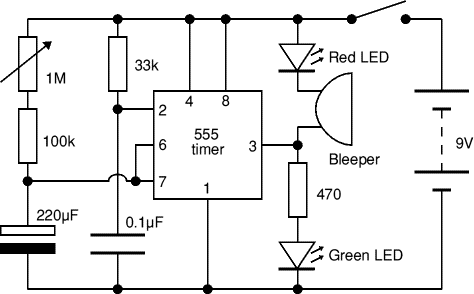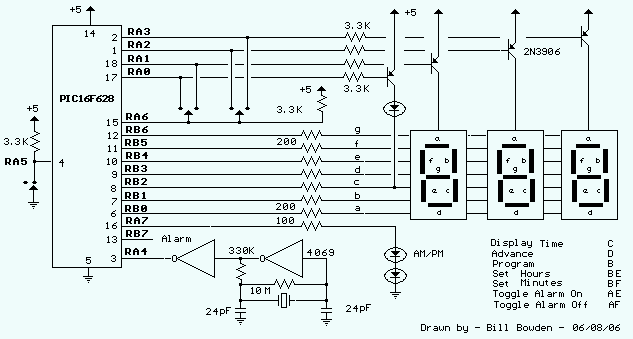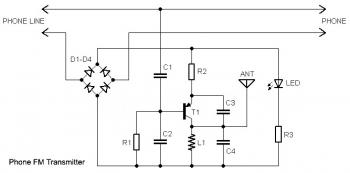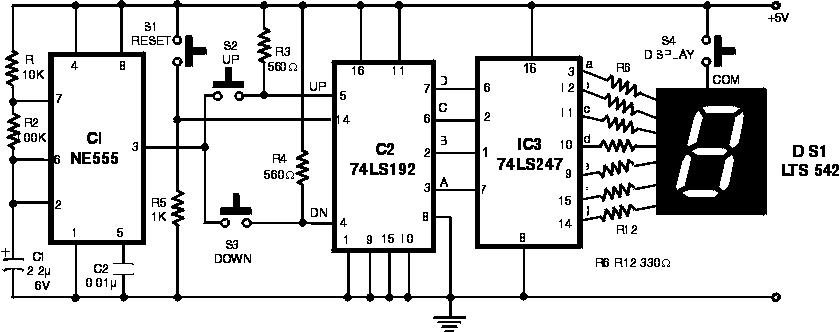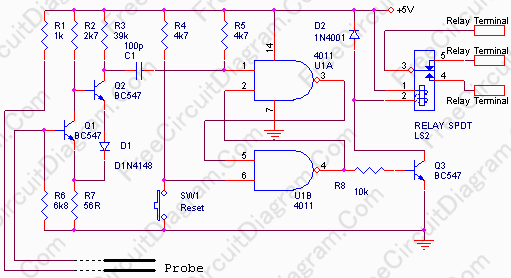
SIMPLE DELAY TIMER FOR ONE MINUTE
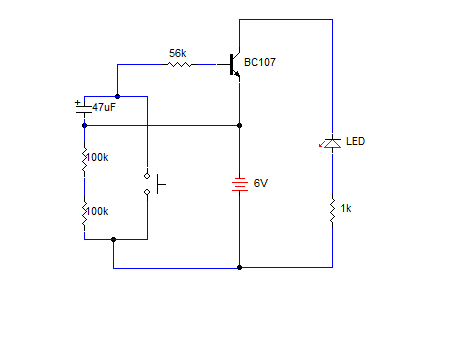
A simple transistorized one-minute delay timer circuit. It does not include any complex or critical components. This circuit can generate a time delay of approximately one minute. When the switch (preferably a push-button type) is pressed, the LED turns on and remains lit for one minute. Upon pressing the switch, the capacitor begins to charge towards 0V through the 100K resistors, and when the switch is released, the capacitor discharges its stored charge through the 56K resistor. This action forward biases the NPN transistor, creating a closed circuit for the LED and battery, which causes the LED to glow. A 1K resistor is employed as a current limiter to protect the LED. Additionally, a relay can be used instead of the LED to control external devices. The circuit remains active until the capacitor has fully discharged. The time duration (delay) of this circuit can be increased by reducing the capacitor value and increasing the resistor values, or by using an NPN Darlington pair instead of the transistor, as illustrated in the accompanying figure.
This one-minute delay timer circuit utilizes a basic configuration of passive and active components to achieve its timing function. The core of the circuit consists of an NPN transistor, which acts as a switch that controls the LED or relay based on the charge state of the capacitor. The charging phase begins when the push-button switch is pressed, allowing current to flow through the 100K resistors into the capacitor. The capacitor gradually charges, and once the switch is released, the stored energy in the capacitor begins to discharge through the 56K resistor. This discharge process causes the NPN transistor to enter a forward-biased state, effectively closing the circuit and allowing current to flow through the LED, resulting in illumination.
The inclusion of a 1K current-limiting resistor is crucial for protecting the LED from excessive current, ensuring its longevity. The option to use a relay in place of the LED broadens the circuit's application, enabling the control of higher power devices or different types of loads.
To adjust the timing characteristics of the circuit, the values of the capacitor and resistors can be modified. Increasing the resistance while decreasing the capacitance will yield a longer delay, while the opposite will produce a shorter delay. Furthermore, substituting the standard NPN transistor with an NPN Darlington pair can enhance the circuit's sensitivity and improve its performance in switching applications, allowing for greater control over the load connected to the output. Overall, this circuit serves as an effective and straightforward solution for applications requiring a timed delay.A Simple Transistorized one Minute Delay Timer Circuit. It doesn`t include any complex or critical parts. You can use this circuit to generate a time delay of about one minute. That is, When you press the switch (Push button type is preferred) the LED turns ON and it prolongs for a 1 minute time. By pressing the switch, the capacitor starts charging towards 0V through the 100K resistors and at the time of release, the capacitor discharges the stored charge through the 56K resistor. This makes the NPN transistor forward biased and it appears as a closed circuit for the LED and battery.
That makes the LED to glow. The 1K resistor is used as current limiting, for the protection of LED. It is possible to use a relay instead of LED, to control external devices. The circuit remains ON till the discharging of capacitor made completed. We can increase the time duration (delay) of this circuit by reducing the value of Capacitor, after increasing the value of resistors. OR, use an NPNDarlington Pair instead of transistor, as shown in figure given below:- 🔗 External reference
This one-minute delay timer circuit utilizes a basic configuration of passive and active components to achieve its timing function. The core of the circuit consists of an NPN transistor, which acts as a switch that controls the LED or relay based on the charge state of the capacitor. The charging phase begins when the push-button switch is pressed, allowing current to flow through the 100K resistors into the capacitor. The capacitor gradually charges, and once the switch is released, the stored energy in the capacitor begins to discharge through the 56K resistor. This discharge process causes the NPN transistor to enter a forward-biased state, effectively closing the circuit and allowing current to flow through the LED, resulting in illumination.
The inclusion of a 1K current-limiting resistor is crucial for protecting the LED from excessive current, ensuring its longevity. The option to use a relay in place of the LED broadens the circuit's application, enabling the control of higher power devices or different types of loads.
To adjust the timing characteristics of the circuit, the values of the capacitor and resistors can be modified. Increasing the resistance while decreasing the capacitance will yield a longer delay, while the opposite will produce a shorter delay. Furthermore, substituting the standard NPN transistor with an NPN Darlington pair can enhance the circuit's sensitivity and improve its performance in switching applications, allowing for greater control over the load connected to the output. Overall, this circuit serves as an effective and straightforward solution for applications requiring a timed delay.A Simple Transistorized one Minute Delay Timer Circuit. It doesn`t include any complex or critical parts. You can use this circuit to generate a time delay of about one minute. That is, When you press the switch (Push button type is preferred) the LED turns ON and it prolongs for a 1 minute time. By pressing the switch, the capacitor starts charging towards 0V through the 100K resistors and at the time of release, the capacitor discharges the stored charge through the 56K resistor. This makes the NPN transistor forward biased and it appears as a closed circuit for the LED and battery.
That makes the LED to glow. The 1K resistor is used as current limiting, for the protection of LED. It is possible to use a relay instead of LED, to control external devices. The circuit remains ON till the discharging of capacitor made completed. We can increase the time duration (delay) of this circuit by reducing the value of Capacitor, after increasing the value of resistors. OR, use an NPNDarlington Pair instead of transistor, as shown in figure given below:- 🔗 External reference
Warning: include(partials/cookie-banner.php): Failed to open stream: Permission denied in /var/www/html/nextgr/view-circuit.php on line 713
Warning: include(): Failed opening 'partials/cookie-banner.php' for inclusion (include_path='.:/usr/share/php') in /var/www/html/nextgr/view-circuit.php on line 713
